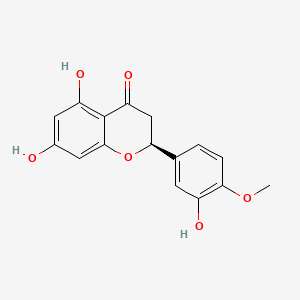| MeSH term | MeSH ID | Detail |
|---|---|---|
| Adenocarcinoma | D000230 | 166 associated lipids |
| Kidney Neoplasms | D007680 | 29 associated lipids |
| Colonic Neoplasms | D003110 | 161 associated lipids |
| Diabetic Retinopathy | D003930 | 39 associated lipids |
| Diabetes Mellitus, Experimental | D003921 | 85 associated lipids |
| Body Weight | D001835 | 333 associated lipids |
| Precancerous Conditions | D011230 | 48 associated lipids |
| Arthritis, Experimental | D001169 | 24 associated lipids |
| Prostatic Neoplasms | D011471 | 126 associated lipids |
| Testicular Diseases | D013733 | 15 associated lipids |
hesperetin
Hesperetin is a lipid of Polyketides (PK) class. Hesperetin is associated with abnormalities such as Corn of toe, Ischemia, Osteoporosis, Consumption-archaic term for TB and Wiskott-Aldrich Syndrome. The involved functions are known as conjugation, inhibitors, Process, mRNA Expression and Adjudication. Hesperetin often locates in Entire intestinal epithelium, Protoplasm, Membrane, Shoulder and Back. The associated genes with Hesperetin are ABCG2 gene, ABCC2 gene, FATE1 gene, ABCB1 gene and P-glycoprotein 2.
Cross Reference
Introduction
To understand associated biological information of hesperetin, we collected biological information of abnormalities, associated pathways, cellular/molecular locations, biological functions, related genes/proteins, lipids and common seen animal/experimental models with organized paragraphs from literatures.
What diseases are associated with hesperetin?
hesperetin is suspected in Corn of toe, Ischemia, Osteoporosis, Diabetes and other diseases in descending order of the highest number of associated sentences.
Related references are mostly published in these journals:
| Disease | Cross reference | Weighted score | Related literature |
|---|
Possible diseases from mapped MeSH terms on references
We collected disease MeSH terms mapped to the references associated with hesperetin
PubChem Associated disorders and diseases
What pathways are associated with hesperetin
There are no associated biomedical information in the current reference collection.
PubChem Biomolecular Interactions and Pathways
Link to PubChem Biomolecular Interactions and PathwaysWhat cellular locations are associated with hesperetin?
Visualization in cellular structure
Associated locations are in red color. Not associated locations are in black.
Related references are published most in these journals:
| Location | Cross reference | Weighted score | Related literatures |
|---|
What functions are associated with hesperetin?
Related references are published most in these journals:
| Function | Cross reference | Weighted score | Related literatures |
|---|
What lipids are associated with hesperetin?
There are no associated biomedical information in the current reference collection.
What genes are associated with hesperetin?
Related references are published most in these journals:
| Gene | Cross reference | Weighted score | Related literatures |
|---|
What common seen animal models are associated with hesperetin?
There are no associated biomedical information in the current reference collection.
NCBI Entrez Crosslinks
All references with hesperetin
Download all related citations| Authors | Title | Published | Journal | PubMed Link |
|---|---|---|---|---|
| pmid: | ||||
| Jeong HJ et al. | Inhibition of aromatase activity by flavonoids. | 1999 | Arch. Pharm. Res. | pmid:10403137 |
| Borradaile NM et al. | Regulation of HepG2 cell apolipoprotein B metabolism by the citrus flavanones hesperetin and naringenin. | 1999 | Lipids | pmid:10405973 |
| Spencer JP et al. | The small intestine can both absorb and glucuronidate luminal flavonoids. | 1999 | FEBS Lett. | pmid:10481070 |
| Doostdar H et al. | Bioflavonoids: selective substrates and inhibitors for cytochrome P450 CYP1A and CYP1B1. | 2000 | Toxicology | pmid:10781868 |
| Johnson MK and Loo G | Effects of epigallocatechin gallate and quercetin on oxidative damage to cellular DNA. | 2000 | Mutat. Res. | pmid:10812333 |
| Xagorari A et al. | Luteolin inhibits an endotoxin-stimulated phosphorylation cascade and proinflammatory cytokine production in macrophages. | 2001 | J. Pharmacol. Exp. Ther. | pmid:11123379 |
| Erlund I et al. | Plasma kinetics and urinary excretion of the flavanones naringenin and hesperetin in humans after ingestion of orange juice and grapefruit juice. | 2001 | J. Nutr. | pmid:11160539 |
| Fang H et al. | Structure-activity relationships for a large diverse set of natural, synthetic, and environmental estrogens. | 2001 | Chem. Res. Toxicol. | pmid:11258977 |
| Zhang M et al. | Effect of six flavonoids on proliferation of hepatic stellate cells in vitro. | 2000 | Acta Pharmacol. Sin. | pmid:11324426 |
